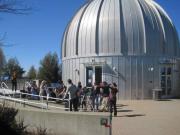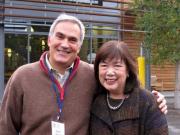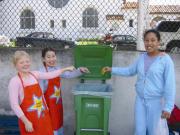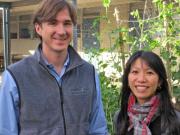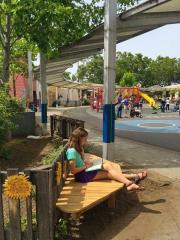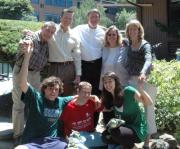New England Environmental Education Alliance, October 21-22, 2010
“Create, Cultivate, Coordinate: Designing our Shared Future”: New England Environmental Education Alliance Annual Meeting (NEEEA), Fairlee, Vermont, October 21-22, 2010
The 44th annual meeting of the New England Environmental Education Alliance (NEEEA) brought together over 250 educators, practitioners and environmental activists in a beautiful retreat center at Lake Morey in Fairlee, Vermont for three days of inspiring keynote addresses, informative workshops, and constructive networking. This is one of the longest running environmental regional groups in the country, and their successful affiliation has been a result of several key factors: New England has had a long reverence for the land, expressed in art, literature, and many outdoor clubs and organizations; the area has developed an unusually large number of non-profit groups devoted to nurturing the environment; the land itself has regained its natural, forested canopy that paints the hills in stunning fall colors and beautiful greens; there are several local universities—University of Vermont, University of New Hampshire, and Antioch University New England--that have developed programs to train environmental educators; and the area has given us national leaders in the environmental movement.
This year’s conference provided ample opportunity to learn about “best practices in
• The Vermont Institute of Natural Science provided a compelling demonstration of their work on behalf of the Connecticut River watershed, including a special appearance of WoW, a watershed on wheels.
• Jen Cirillo and Anne Tewksbery-Frye provided an inspirational report on their partnership between Shelburne Farms environmental education program and the Sustainability Academy in Burlington, the first public elementary school in the country devoted to sustainability.
• Judy Filkins, Curriculum Coordinator in Lebanon, New Hampshire schools reported on “Place-based professional development” that “meets teachers where they are.”
• Barbara Duncan from the North West Earth Institute (NWEI) based in Portland, Oregon, told about cultivating sustainable communities through an on-going dialogue program.
• Marie Silver from the STEM Education Institute at the University of Massachusetts reported on how after school students can be engaged in sustainability projects sponsored by research universities.
• Damien Raffa from the Presidio Trust in San Francisco described how the Stewardship and Environmental Education Collaborative (SEEC-SF) has created a tapestry of environmental programs in the City.
• Sarah Bevilacqua from the US Forest Service described how the Watershed on Wheels program brings ecosystem education around New England.
• Andy Shapiro, an energy scientist, gave a hands-on workshop on the integrated, K-12 curriculum on energy offered free to Vermont schools by Vermont Energy Education Program (VEEP).
• Sue Quarry from the Department of Environmental Protection in Connecticut described the Food, Land and People” curricular program and illustrated the resource with three demonstration lessons on composting, clothing and erosion.
The most inspiring workshop was “Environmental Literacy Across New England,” a series of six reports from the member states on their work over the past year to craft Environmental Literacy Plans (ELP) in response to the No Child Left Inside legislation introduced by a Rhode Island congressman that promises to provide $100M a year for environmental education in the states for five consecutive years, a kind of “green race to the top.” The reports were filed by the following individuals who have posted their power points on the NEEEA sites:
• Vermont--Lisa Purcell and Jen Brown, from SWEEP and Four Winds, Creating a Road Map for Vermont Environmental Literacy
• Massachusetts--Jennifer Gresham, Education Director, Zoo New England, Environmental Working Group Update
• Rhode Island--Christen Swanberg, Audubon Society, Responding to NCLI
• Connecticut--Sue Quincy, Connecticut Outdoor Environmental Education Alliance, Using the Logic Model to Shape Reform
• New Hampshire--Amy Yeakel, Squam Lakes Science Center, Direct Presentations to Government Leaders on Reform
• Maine--Kara Wooldrik, Friends of the Cobbsriver Watershed, Using Community Dialogues
The ELP movement strikes me as a major opportunity to promote environmental education reform since it is concrete, tied to the existing state core standards, measurable, and scaleable, especially since almost all the 50 states are involved.
Our two keynote speakers gave us much to think about. Peter Forbes, a Dartmouth alum and former head of the college’s outdoor program who worked for the Trust for Public Land in San Francisco, spoke about the “need to make more room at the table for others in our love of place.” Earlier in his career he took a more political, advocacy role, but in his Center for Whole Communities in the Mad Valley in Vermont, he brings a diverse group of people for workshops on how to build community. He recalled the words of Chief Joseph as his inspiration: “the longest journey any of us makes is from the head to the heart.” He also introduced us to a wonderful video, playingforchange.org, that brought street musicians from around the world to perform “Stand By Me.” His analytic grid, with Nature and People on the Y-axis, and Haves and Have Nots on the X-axis, graphed people’s typical environmental positions based on their relative value orientations and their status characteristics.

The NEEEA is an extraordinary network of committed environmental educators whose long-term association can serve as a model for developing regional collaboratives around the country.
